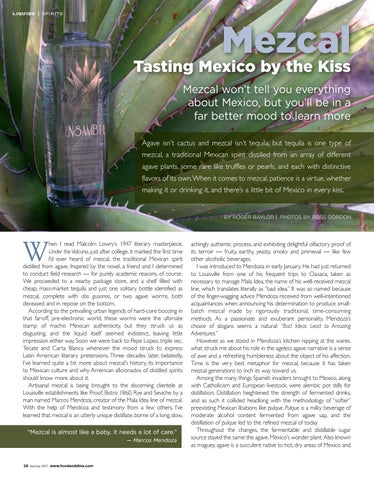liquids | spirits
Mezcal Tasting Mexico by the Kiss Mezcal won’t tell you everything about Mexico, but you’ll be in a far better mood to learn more Agave isn’t cactus and mezcal isn’t tequila, but tequila is one type of mezcal, a traditional Mexican spirit distilled from an array of different agave plants, some rare like truffles or pearls, and each with distinctive flavors of its own. When it comes to mezcal, patience is a virtue, whether making it or drinking it, and there’s a little bit of Mexico in every kiss.
BY ROGER BAYLOR | PHOTOS BY ROSS GORDON
W
hen I read Malcolm Lowry’s 1947 literary masterpiece, Under the Volcano, just after college, it marked the first time I’d ever heard of mezcal, the traditional Mexican spirit distilled from agave. Inspired by the novel, a friend and I determined to conduct field research — for purely academic reasons, of course. We proceeded to a nearby package store, and a shelf filled with cheap, mass-market tequila and just one solitary bottle identified as mezcal, complete with dos gusanos, or two agave worms, both deceased and in repose on the bottom. According to the prevailing urban legends of hard-core boozing in that far-off, pre-electronic world, these worms were the ultimate stamp of macho Mexican authenticity, but they struck us as disgusting, and the liquid itself seemed indistinct, leaving little impression either way. Soon we were back to Pepe Lopez, triple sec, Tecate and Carta Blanca whenever the mood struck to express Latin American literary pretensions. Three decades later, belatedly, I’ve learned quite a bit more about mezcal’s history, its importance to Mexican culture and why American aficionados of distilled spirits should know more about it. Artisanal mezcal is being brought to the discerning clientele at Louisville establishments like Proof, Bistro 1860, Rye and Seviche by a man named Marcos Mendoza, creator of the Mala Idea line of mezcal. With the help of Mendoza and testimony from a few others, I’ve learned that mezcal is an utterly unique distillate, borne of a long, slow, “Mezcal is almost like a baby. It needs a lot of care.” — Marcos Mendoza
28 Spring 2017 www.foodanddine.com
achingly authentic process, and exhibiting delightful olfactory proof of its terroir — fruity, earthy, yeasty, smoky and primeval — like few other alcoholic beverages. I was introduced to Mendoza in early January. He had just returned to Louisville from one of his frequent trips to Oaxaca, taken as necessary to manage Mala Idea, the name of his well-received mezcal line, which translates literally as “bad idea.” It was so named because of the finger-wagging advice Mendoza received from well-intentioned acquaintances when announcing his determination to produce smallbatch mezcal made by rigorously traditional, time-consuming methods. As a passionate and exuberant personality, Mendoza’s choice of slogans seems a natural: “Bad Ideas Lead to Amazing Adventures.” However, as we stood in Mendoza’s kitchen nipping at the wares, what struck me about his role in the ageless agave narrative is a sense of awe and a refreshing humbleness about the object of his affection. Time is the very best metaphor for mezcal, because it has taken mezcal generations to inch its way toward us. Among the many things Spanish invaders brought to Mexico, along with Catholicism and European livestock, were alembic pot stills for distillation. Distillation heightened the strength of fermented drinks, and as such it collided headlong with the methodology of “softer” preexisting Mexican libations like pulque. Pulque is a milky beverage of moderate alcohol content fermented from agave sap, and the distillation of pulque led to the refined mezcal of today. Throughout the changes, the fermentable and distillable sugar source stayed the same: the agave, Mexico’s wonder plant. Also known as maguey, agave is a succulent native to hot, dry areas of Mexico and
